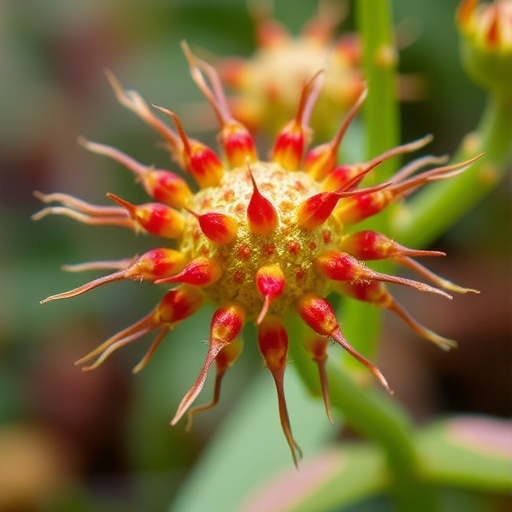In the ever-expanding field of microbiology, researchers are continuously exploring the unique capabilities of microbial organisms to adapt to extreme environments. A recent study highlights the extraordinary genetic properties of a mercury-tolerant yeast strain known as Pichia kudriavzevii 1P4. This remarkable organism has exhibited a noteworthy ability to thrive in environments heavily contaminated with mercury, a toxic heavy metal that poses significant health risks to both humans and the ecosystem.
The study, conducted by Astuti, R.I., Maulana, I., Wahyuni, W.T., and their colleagues, delves into the mechanisms that enable Pichia kudriavzevii to resist the adverse effects of mercury. The findings underscore the potential of this yeast not only as a model for studying metal tolerance at the genetic level but also as a possible bioremediator in the cleanup of mercury-polluted environments. The implications of this research extend beyond basic science; they offer hope for future applications in environmental biotechnology.
At the genetic level, the research team employed advanced sequencing technologies to analyze the genome of Pichia kudriavzevii 1P4. The genetic information revealed a suite of genes that are upregulated in the presence of mercury. These genes play crucial roles in detoxifying the toxic metal, enabling the yeast to survive and proliferate in inhospitable conditions. Understanding these genetic mechanisms is vital, as it paves the way for potential applications in bioremediation strategies aimed at mitigating the effects of mercury pollution in contaminated sites.
.adsslot_hs2b3CqTX6{width:728px !important;height:90px !important;}
@media(max-width:1199px){ .adsslot_hs2b3CqTX6{width:468px !important;height:60px !important;}
}
@media(max-width:767px){ .adsslot_hs2b3CqTX6{width:320px !important;height:50px !important;}
}
ADVERTISEMENT
One of the standout features of this yeast strain is its ability to accumulate mercury within its cells. The researchers found that Pichia kudriavzevii 1P4 exhibits a high affinity for mercury ions, potentially leading to the development of yeast-based biosensors to monitor mercury levels in various environments. This accumulation mechanism is significant not only for bioremediation efforts but also for environmental monitoring, where timely detection is critical to preventing mercury from entering the food chain.
Furthermore, the study’s findings emphasize the potential for employing Pichia kudriavzevii in sustainable agriculture. The ability of this yeast to tolerate high levels of mercury could allow for safe cultivation in contaminated soils, thereby providing a unique solution to soil reclamation efforts. By harnessing the properties of this yeast, agricultural practices can potentially integrate bioremediation processes that enhance soil health while simultaneously addressing pollution issues.
The research also touches upon the significance of horizontal gene transfer among microorganisms, a mechanism that can facilitate the spread of mercury resistance traits. This is particularly notable in the context of environmental microbiomes, where diverse microbial communities interact and exchange genetic material. Understanding the dynamics of these interactions could inform strategies for utilizing Pichia kudriavzevii in bioremediation and microbial management, crucial for ecological restoration projects.
Moreover, the implications of this study stretch into the broader realm of public health. Mercury exposure is associated with severe neurological and developmental issues in humans; thus, the insights gained from Pichia kudriavzevii 1P4 could be key in developing innovative methods to reduce mercury levels in agricultural and aquatic ecosystems. As researchers delve deeper into the genetics of this yeast, potential therapeutic applications may emerge, contributing to a decrease in mercury-related health risks.
The study also highlights the importance of interdisciplinary collaboration in advancing research in microbial biotechnology. By combining the expertise of microbiologists, geneticists, and environmental scientists, the researchers were able to uncover the intricate genetic pathways that confer mercury tolerance in yeast. This collaborative approach is essential for addressing complex environmental challenges faced by modern society.
As the urgency of addressing pollution grows, the role of microbial organisms like Pichia kudriavzevii will become increasingly vital. The potential for this yeast to contribute to environmental restoration efforts offers a beacon of hope, reinforcing the concept of utilizing nature’s own tools for combating ecological degradation. Researchers envision that with continued exploration and genetic manipulation, the capabilities of this yeast strain can be enhanced, increasing its effectiveness in bioremediation applications.
In conclusion, the groundbreaking research surrounding the genetic properties of Pichia kudriavzevii 1P4 highlights its remarkable mercury tolerance and potential applications in environmental remediation, agriculture, and public health. The insights garnered from this study provide a foundation for developing innovative solutions to one of the pressing environmental issues of our time, reaffirming the vital role of microbial life in creating a sustainable future.
By advancing our understanding of mercury-tolerant organisms, scientists are poised to harness the untapped potential of nature for addressing pollution challenges. The future may see Pichia kudriavzevii not only as a model organism for study but also as a key player in the efforts to reclaim and restore our contaminated environment, showcasing the resilience and adaptability of life even in the most challenging conditions.
Subject of Research: Mercury-tolerant yeast, Pichia kudriavzevii 1P4
Article Title: Genetic properties of mercury‑tolerant yeast, Pichia kudriavzevii 1P4
Article References:
Astuti, R.I., Maulana, I., Wahyuni, W.T. et al. Genetic properties of mercury‑tolerant yeast, Pichia kudriavzevii 1P4. Int Microbiol (2025). https://doi.org/10.1007/s10123-025-00666-3
Image Credits: AI Generated
DOI: https://doi.org/10.1007/s10123-025-00666-3
Keywords: Mercury tolerance, Pichia kudriavzevii, bioremediation, environmental microbiology, toxicology, genetic mechanisms, microbial biotechnology, pollution mitigation, sustainable agriculture, environmental restoration
Tags: advanced genome sequencing in microbiologybioremediation of mercury contaminationenvironmental biotechnology applicationsenvironmental microbiology studiesgenetic analysis of metal tolerancehealth risks of mercury exposureheavy metal detoxification mechanismsmercury resistance in microbial organismsmercury-tolerant yeast researchmicrobial adaptation to extreme environmentsPichia kudriavzevii genetic propertiesyeast strains in pollution cleanup





